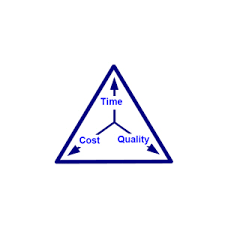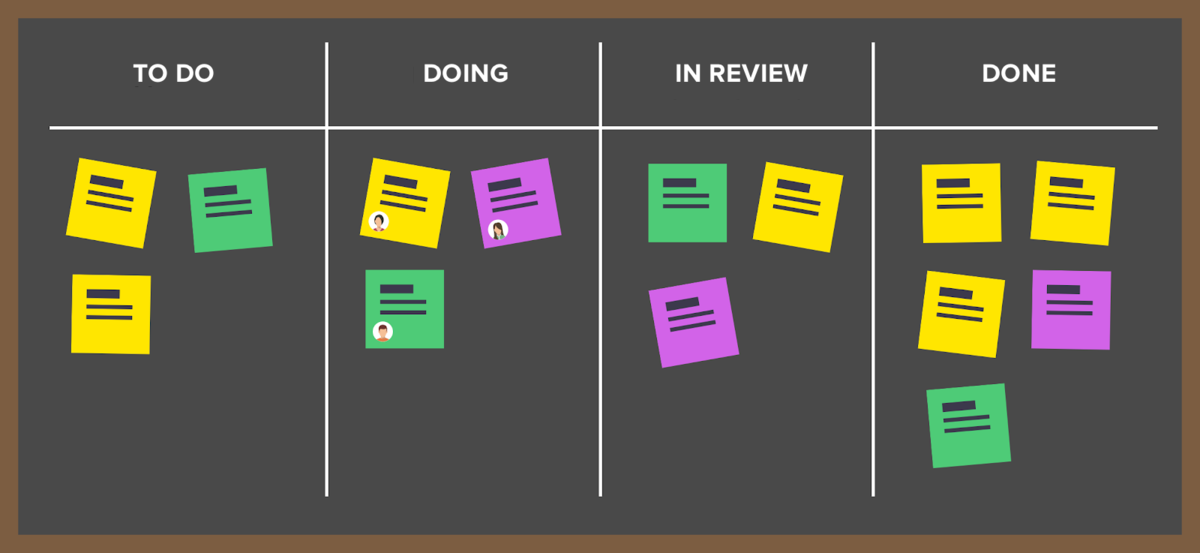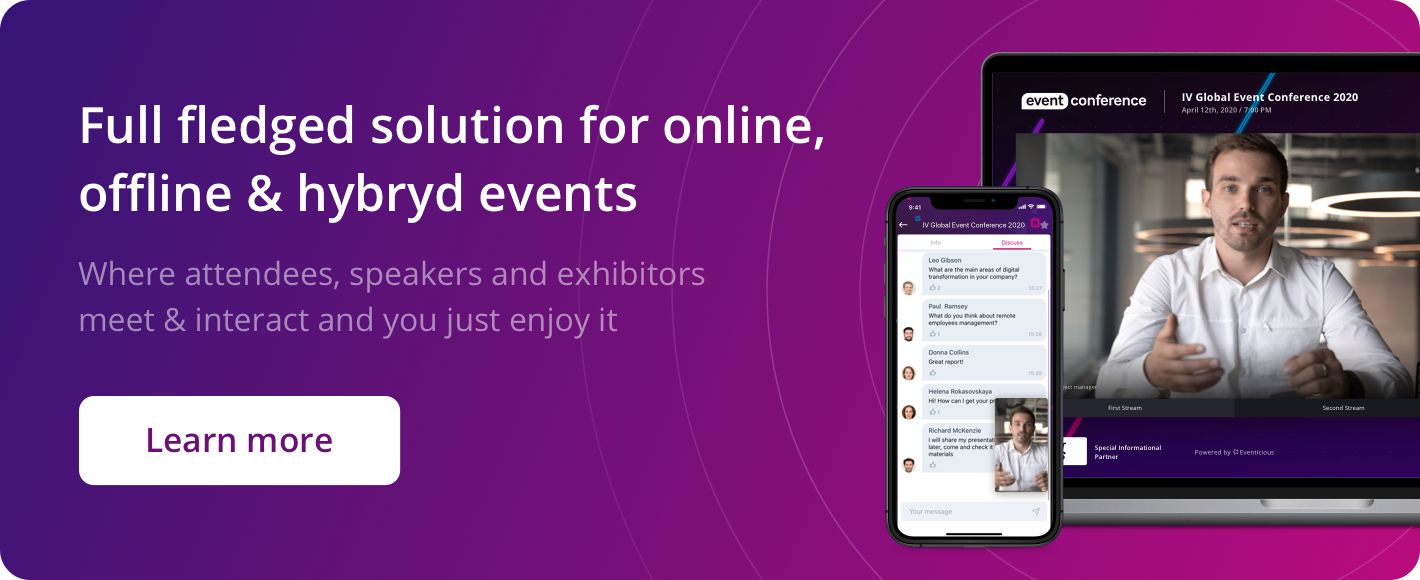Organizing an event is essentially the same as working on a project. There are not many differences between creating a mobile application and organizing a business conference, because in both cases we have a project team struggling to achieve a predefined goal in conditions of a limited budget, tough deadlines and constantly changing requirements.
In Eventicious we not only create a product using an Agile approach; every year we also take part in organizing two large-scale annual conferences with over 1,000 participants each.
In addition to that, we communicate extensively with organizers of events that use our apps, we attend industry events, and consult on event technology.
And here is what we came to understand about events from our experience: event = project
This means that Agile methodologies could be used by event management industry in the same way as they are used by mobile app development industry.
Trade-off triangle
Regardless of what we are trying to build, an event or an IT product, we always have to deal with a “trade-off triangle”, or “iron triangle”.
Three constraints of any project: time, cost and quality.
If we want faster results, then we need to spend more money, otherwise the quality will suffer. If we cut the budget, we will have to sacrifice some quality, or we won’t be able to meet the deadline. And so on.

To be more precise, this picture lacks a fourth dimension: requirements. If we as event organizers, or our clients, have set some insanely high requirements, those will need to be supported by a reasonably large budget, otherwise everything else will fall apart.
What’s wrong with Waterfall?
The Waterfall model is the classic project management methodology best illustrated with a Gantt Chart.

When applied to organizing an event, this approach usually works as follows. First, we spend a lot of time collecting customer’s requirements. If we are an event agency working for a client, we discuss all the details of the concept trying to perfect and finalize everything.
Or, if we ourselves are the client, we have long and detailed discussions with the team. After that, we distribute tasks within the team, and everyone does their share of the work by the deadline.
The Waterfall model has several advantages:
- You have a solid plan right from the start.
- Everyone knows what they need to do at all times.
- The result is always predictable.
However, there is one problem: no plan works 100% of the time. Ever.
Why? Because of changes! Something can go wrong at any minute.
The classic approach does not accommodate constant changes and risks:
- Clients suddenly decide they want something totally different .
- Budget or timeline changes.
- Changes in resources (people moving on, getting sick, etc.)
- Changes due to unforeseeable circumstances (technical risks or force-majeure)
So, the final result can be very different from what the event organizers anticipated.

Why Agile?
An alternative to the classic waterfall model is a flexible Agile project management approach
Someone might say “We don’t use Waterfall, that’s for sure, so we must be using Agile” Well, it’s not that simple.
First, answer this question: do you have ANY project management process in place? Do you have well-defined rules and workflows to be followed by all team members on each project?
Agile Manifesto describes 12 agile principles. Here are the most popular ones:
- Requirement changes are welcome!
- The highest priority is to satisfy the customer through early and continuous (every 1-2 weeks) delivery of demos.
- Business people and developers must work together daily throughout the project (one team).
- Project is built around equal and motivated professionals.
- Teamwork is based on support and trust.
- Delivering valuable product is the first priority. Secondary details are set aside. Self-organizing team that constantly tunes and adjusts its processes.
The image below provides the best illustration of the differences between Agile and Waterfall approaches.

In a classical process, the product remains unusable practically until the very last stage because it still lacks crucial elements. A viable and valuable product is delivered only in the very end (when you have achieved 100% of the goal, if you live to see that day).
In an Agile process, you have a viable product at each iteration, and the value of the product continues to grow each step of the way.
When applied to organizing events, Agile approach means that first you spend resources on things that are essential for your event.
Starting from the very first iteration, you complete the most important and basic tasks, living optional knick-knacks for later.
With this approach, if it happens that conference tickets don’t sell like hotcakes and, before you know it, you run out of budget, the event will still take place. There just won’t be any limos and champagne for the key speakers.
Agile project management
The most popular Agile project management tools are SCRUM, Kanban and Lean. The process of managing a project with the help of these tools looks approximately like this:
- Project development timeline is split into short (usually 2-4 weeks) iterations (sprints).
- You select the most important tasks and strip away everything non-essential (with participation of the customer or their representative on the team).
- Team members select their own tasks.
- You hold daily status meetings where team members share what they did yesterday, what they will be doing today and what problems (obstacles) they face.
- At the end of each sprint, you have a demo meeting where the progress achieved is demonstrated to the customer and their feedback is collected.
- You regularly do retrospective analysis, discuss what could have been done better or more efficiently, and continuously adjust the process.

Main advantages of Agile approach
- this approach is ideal when there is not enough time to finalize the roadmap and requirements (for example, when you need to start right away);
- it is easily adaptable to any changes;
- the final deliverable is usually of a higher quality and greater value to the client (because you regularly adjust to accommodate your client’s changing requirements instead of sticking to a once-set plan that can turn out to be incorrect).
However, this approach also has some disadvantages:
- not everyone is cut out for Agile (it requires experience, responsibility and initiative);
- business/client must be 100% involved and prepared to be flexible (in regards to budget, timeline, requirements);
- cost is not set in stone and specification does not include each and every detail;
- higher degree of uncertainty (constantly changing requirements).
It’s quite understandable that not all clients are ready for an Agile process with its “flexible budget” and “variable results”. It requires dedication from both customer and vendor.
That’s why it often feels like you cannot use Agile methodology in real-life situations when you have a client with a fixed budget.
Still, Agile approach by itself does not mean that the budget must be “flexible”. This flexibility can be achieved by balancing other parameters (requirements, timeline, quality, etc.).
You must remember that your process can and must be fine-tuned by selecting practices that suit this particular project (which is what the Agile approach is about)
In some cases, it makes more sense to use a hybrid approach to project management
Here’s how you could do a hybrid approach: use traditional practices to manage the project on the whole — “visualized" requirements and project roadmap with deadlines and a fixed estimate.
At the same time, use Agile methodology (but with a fixed budget) to manage sub-projects within that project, for example, the conference website or venue setup, focusing on interactivity, client demos, collecting feedback and being ready for changes.
Teamwork tools
When preparing an IT conference for 1,500 attendees, we used several free and simple tools:
- Google Docs & Sheets are ideal for working on text documents and spreadsheets in collaboration with other people
- Trello is an electronic version of Kanban board. Each task goes through four stages: To Do, In Progress, Verified, and Done. You can create task lists that look like cards, link team members to cards and move cards between different boards.
If your projects are on the larger side and you feel that Trello is not enough, you may want to take a look at other project management tools. The most popular ones in the IT industry are Basecamp, Asana, Jira, and MS Projects.

Predictable risks
One of the key aspects of the traditional project management process is risk management.
Agile approach is better suited for situations when something goes wrong, but when a risk becomes a reality, things can quickly get out of hand. That’s why we recommend doing risk analysis before embarking on a project.
It is important to understand in advance what risks you may be facing, evaluate their probability and think about ways of reducing it.
To do that, make a list of possible risks, for example:
- a key speaker fails to show up
- the venue becomes unavailable at the last moment
- tickets are selling worse than anticipated
and so on
Next, have a plan B (mitigation plan) ready in case a risk materializes. Estimate how much time and money it will take to mitigate the consequences and, when planning preparation timeline and budget, add a little extra for each risk, taking into account its probability.
Alternatively, you can leave risk management to your client. In that case, create a risk register and have your client sign off on it (in IT projects, a risk register is often attached to the contact). As you move along with the project, go back to the risk register on a regular basis to make sure that no new and unaccounted for risks have come up.
Here’s the gist of risk management: address the most complex and risky parts first and make sure they are doable as early into the project as possible!
For example, if your town has only one venue that can accommodate the event you are planning, your top priority should be securing that venue by signing a contract with its owners.

Prototype that!
Under the Agile approach, it is important that you show your customers a prototype as early as possible.
Any visualization works much better than verbose documentation and specifications.
Most likely, the customer won’t read them anyway, and then, several months into the project, you suddenly find out that the concept you described is not what the customer had in mind. Scale models, sketches, 3D visualizations, comic strips showing event scenario – there are many ways of showcasing an event prototype.
Prototyping is an excellent tool for implementing large-scale projects. Nobody is going to implement three versions of a stadium setup in three iterations, but it’s quite feasible to make three models or three 3D visualizations. The customer can see for themselves what the result will look like and make necessary adjustments at the prototype stage. This can save a lot of resources and alleviate risks.
Even in the situations when Agile does not seem the right way to go, prototyping can really help to avoid “misunderstandings”. A classic example is a scale model of a new building surrounded by existing ones, which is shown to customers before they sign off on the project.
Track actual expenses and actual progress
In the IT industry, a team working on a project will always keep track of the time and money spent on each task.
If we have spent 50% of the time or the budget but completed only 10% of the project, or if expenses keep piling up but the task is not moving forward, then it’s time to raise the alarm!
It means something has gone wrong. We need to find out why, and where we deviated from the plan.
The same approach can be used in event management. Some project management tools allow to track spent time and resources and automatically produce reports. Or you can track these parameters manually using data shared at daily team meetings.
What should we do if, while working on a task, we find that our results differ from forecasts? First, we may want to adjust our estimates for similar tasks handled by that particular individual or team. Second, we may want to adjust our processes. Maybe there are things that could be automated to reduce the costs? Also, we might need to stock up on templates and checklists.
Changes are a good thing
The main advantage of Agile approach in managing any project, be it developing an application or organizing a conference, is a completely different attitude to changes and a readiness to meet customer expectations as much as you can. With Agile, you know that changes are inevitable (something is bound to go wrong), you are ready to face them, and you see them as an inherent part of the process.
The best ideas are never born at the preliminary planning stage, they usually appear when the event preparation is in full swing.
If you welcome changes and consider them the best part of working on a project, not just a necessary evil, then you have a chance to create something really amazing.
More tips for event planners:



